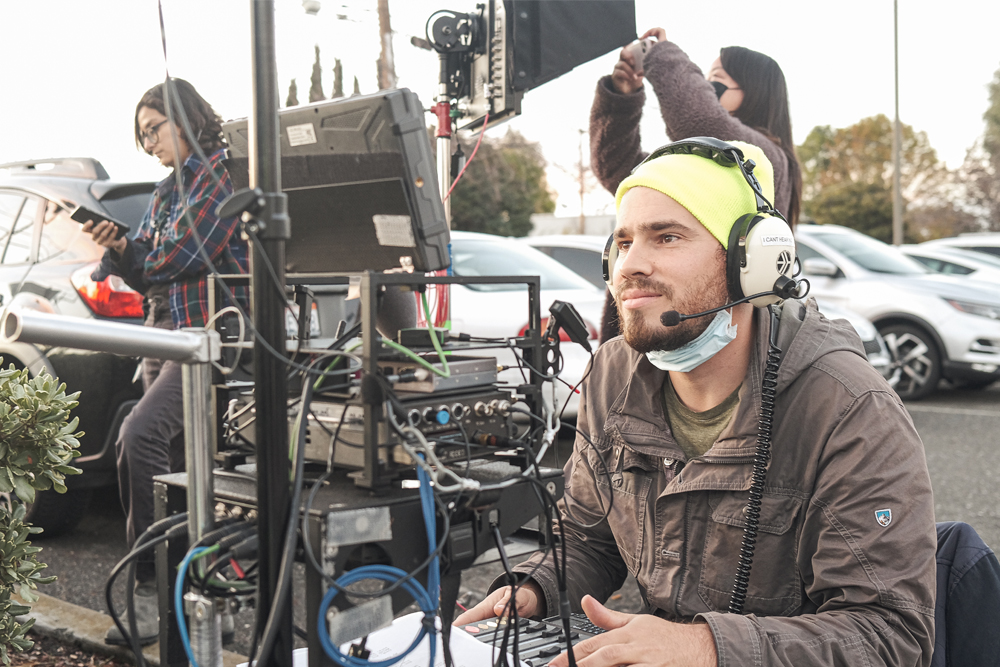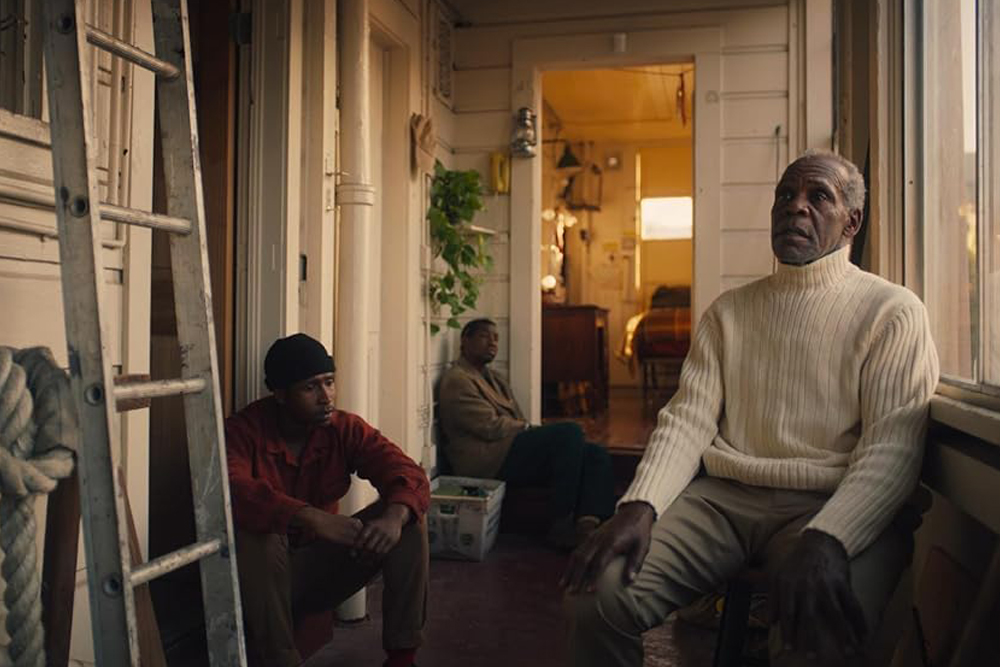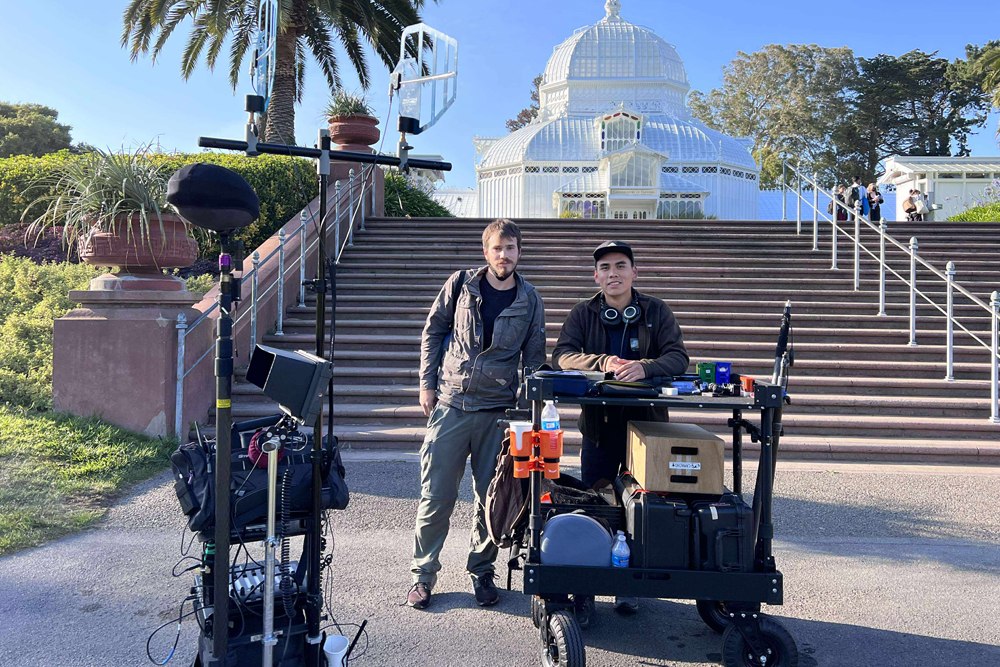
In Killing Them Softly there’s a scene where Markie (Ray Liotta), a petty gangster, sits alone in his car as it’s pouring rain like nails tapping a tin cup. As he waits at the red light, hitman Jackie Cogan (Brad Pitt) pulls up in a car next to him and guns him down. The moment is filmed in slow motion, heightening the sense of tragedy. We see the coil of the gun and a plume of white smoke before the bullet explodes through the driver’s side window. A second shot is fired, striking Markie in the head, blood sprays across the interior as his body violently recoils in the seat. Then more shots ring. Juxtaposing the violence is a visceral muted sound design. The song “Love Letter” by Ketty Lester harmonizes the gunshots and shattering glass, giving an almost surreal, dreamlike atmosphere. As Jackie drives away, a pickup truck crashes into Markie’s vehicle over and over again, finishing the job. It was seeing this very sequence that sparked Sage Bilderback’s interest in sound.
“I was able do a movie with Scoot McNairy a couple years back and that was really meaningful, both because Killing Them Softly was important, but also like many people my age, Monsters is what made me get into independent filmmaking,” recalls Bilderback, who’s been working as a production sound mixer for over a decade on films, television, commercials, and everything in between. Recent credits include the TV series Hanging with Dr. Z, the Sofia Coppola produced film Fairyland, and Al Pacnio’s upcoming film Billy Knight from director Alec Griffen Roth.
Originally from small town Alaska, Bilderback has traveled down North America’s West Coast, stopping in Spokane to attend Eastern Washington University where he studied screenwriting and filmmaking. Post graduation he was able to find more jobs in the sound department than in other fields, and shortly, he realized he had a talent for it. “Sound wasn’t a niche I got to explore in film school, so I didn’t realize I was good at it. But it’s kind of how my brain works, both acoustically and the problem solving that you have to do to work with and around other departments,” he says.

While living in The Golden City, he worked on films like The Last Black Man in San Francisco, from director Joe Talbot about a man obsessed with reclaiming the Victorian house that he believes his grandfather built in the 1940s. Originally a short, Bilderback mixed both projects with boom operator Corryn Deegan joining him on the single camera feature. The critically acclaimed project was one of his last before switching to a full Zaxcom setup. When asked why the change in gear he says, “There are a lot of advantages with Zaxcom. I know not everyone comes to this, but for me, it’s just how small the wireless are. What’s important to me is being able to use tools for multiple reasons, which is why even as other companies have caught up, I’ve stuck with Zaxcom.”
Today, Bilderback makes Los Angeles his home and is a proud member of IATSE Local 695. His sound package has evolved to include the Zaxcom Nova, a 16 channel mixer and recorder, the Aria-8 control surface, multiple ZMT4, and TRX743 wireless, the latter of which is used for wireless boom and paired with Schoeps microphones and Ambient boompoles. Zaxcom URX100 and VRX1 are used for communications and IFB. “There are two things Zaxcom does that makes my life easier: weight and routing flexibility. The Nova and its internal receivers have made it possible to do more intense bag work into my 30s, and the ZMT4s make boompoles light and the wardrobe department happy,” he says. “As I continue to bounce between the feature and doc worlds, the flexibility of having receivers on cameras as well as the onboard recording allows cameras to splinter off and capture important moments, and I rarely have to say “no” when workflow problems arise. It’s a very nice feeling to always be able to say “yeah, we can do that, give me 5 minutes to adjust,” and of course, it awards you lots of grace with production.”

The production mixer put the gear through its paces during a boxing match between YouTube star turned fighter Jake Paul and former MMA fighter Ben Askren that took place at the Mercedes-Benz Stadium in Atlanta, Georgia. The mixers says, “The production company involved didn’t know how to operate on this scale and hired seven sound mixers to pair off with seven cameras; a nice gesture, but without proper coordination it caused more problems than it solved.” To standardize the workflow, two mixers, one that included Bilderback, stepped up to be audio supervisors and organized everything between the 14 units.
“I was covering all these segments with Snoop Dog, Pete Davidson, Ric Flair, Doja Cat, and all these different influencers and rappers,” he recalls. “There was a really crazy RF environment so we recorded onboard the Zaxcom transmitters because there wasn’t enough time to run scans and fix everything.” Bilderback also took advantage of ZaxNet while on the project, which allows users to remotely control key features of Zaxcom transmitters. “I was able to send the lavs to camera, or change the frequency from my Nomad while we were moving around. I had to constantly hop and adjust because we were getting about 10 feet of reception on the arena floor.” For communications within his sound department, he used a URX100 so the team could speak a private line but the boom operator or utility could also listen into the production audio at any time. Likewise while on Billy Knight, the mixer used a URX only system for crew communications and had a significant amount of earwig integration as part of his workflow.
On the film Edge of Everything (2023) from directors Pablo Feldman and Sophia Sabella, which stars Sierra McCormick as a teen forced to move in with her father and younger girlfriend after her mother’s passing, Bilderback had a more traditional approach to his mix. Track one being his mono mix track followed by the boom and ISO tracks from wireless transmitters. “My workflow is that I try to mic everyone possible. Not every scene needs a lavs on talent but you never know how things are going to change, so it’s not a bad idea to be safe about it.” For certain scenes Bilderback admits he wouldn’t have been able to record them without Zaxcom. “There is a long scene where a group of girls are walking down an alley and then they stop to do some drugs. They are talking the entire time and I wouldn’t have been able to mic any of them up if I didn’t have Zaxcom’s small and lightweight transmitters. Some of the girls are basically wearing a bandana as a top but I was still able to find a place for the transmitter.”

When asked about collaborating with two directors he mentions, “The complication can come down to whom you talk to when you have a sound issue or an approval but they worked really well together. For me, I approached whoever was closest and not in conversation with someone else. I never felt like we were losing time based on their internal communications with what was happening on set.”
While recording American Nightmare (2024), a three part true crime documentary on Netflix that uncovers the horrible tragedy of a woman being accused of faking her own kidnapping, the mantra was to stay nimble. Production traveled to multiple cities throughout California and Arizona with Bilderback sharing mixing duties with Kevin Crawford and Seth Peterson to record the expansive storyline. The most emotional being the on-camera interviews, which reveal the shocking details and trauma of victim Denise Huskins’ kidnapping. For emotional moments, Bilderback tries to not let the tragedy of a story overwhelm him. “I try to let the sound wash over me on jobs where I don’t need sound cues. Instead I am listening to the background for things like trains and motorcycles because these documentaries are essentially getting authentic performances out of people who are not actors and can’t do it again.”
To record interviews Bilderback wires the talent with a Zaxcom transmitter and a nearby boom overhead. For trickier recordings, he was able to devise a custom piece of kit. “We did an interview in the car and I was able to use a Schoeps CMC 1 K, a magnetic version of their smallest preamp that directly plugs into a lemo connector and used it with the ZMT4. This is honestly the most useful tool in my kit as I can hide a good plant virtually anywhere. Not to mention the on-board recording for car rigging and car to car recording is very helpful.”
When asked what one thing he’s learned from his career, he tells us, “It’s important not to get personally bothered about things while still fighting to do a good job. I really admire the people who are able to just nod, and be like, ‘we can do that…’ even when those in charge may not understand what the limitations are of sound.”
You can connect with Sage Bilderback through his website holdforplane.com.